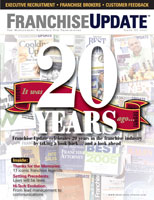Understanding today's employees - and how to motivate them!
If history has taught us anything, it’s that not all good things from the past necessarily follow us into the future. Employee attitudes and work ethics that were around two decades ago are no exception.
Franchise owners are experiencing today, more than ever, the crossover of generations in the work force. One out of every 16 employees is employed by a franchised employer. The significant portion of those franchises are food centric, and in the past that has been dominated by younger workers. But that’s evolving, too.
Generation gaps are nothing new.
Four generations exist in today’s workplace; the Traditionalists, Baby Boomers, Generation X, and the Millenials (Generation Y). They all bring with them unique views and work habits that are shaping our marketplaces. Boomers, aged 45 to 61, have dominated the workplace for more than four decades, and many are still too energized to retire (yours truly included), and choose to stay busy. Generation X, aged 25 to 40 years, are now managing the Millennials (which they prefer to be called) aged 13 to 27, and are grasping for the silver bullet on how to motivate them.
Gen-Xers came seeking employment for the first time 20 years ago. They won’t admit it, but they are most like the succeeding generation, the Millennials. The Millennials are an extreme and supercharged generation. They are also known as Nexters or the Gaming Generation, and are just now entering the work force. Already they are changing the rules and taking names. In fact, if you the employer are not meeting the expectations of these young workers, they can alert their friends in a nanosecond, with the click of a mouse or the push of a keypad (and they will).
So what does this mean to us business owners? To some of us it may mean an attitude overhaul - our own, especially if we are one of the 75 million Baby Boomers and operating our own business. I’ll admit I am one of them. We already have a predisposed judgment against slothfulness. We respect the fact that our parents had to walk through a mile of two-foot snowdrifts to get to school in their handed-down sandals, but let’s face it: Boomers knew the meaning of the word "work." We did not ask what a company could do for us, we asked what we could do for the company, and did it without complaining.
This Boomer group is the most resistant to change, and therefore finds it hard to embrace the young workers of today. Let me remind you we have 76 million reasons why we need to change. After all those years of being the biggest, Boomers now have to realize that Millennials now outnumber them.
Baby Boomers even have a hard time with Gen-Xers. We fail to understand why they demand so much, while lacking loyalty and stick-to-it-iveness. But the fact is that as employers we have no alternative but to embrace the cultural and ethical differences at a time such as this and use them to our advantage.
Geoff Baker is a third-generation Dairy Queen operator, and owned his first store in 1976. Currently he is a multi-unit area developer in Ohio and Pennsylvania, and says: "I’m not sure there is a huge difference in workers now versus 20 years ago. I think kids just are connected in ways we never knew and they are extremely savvy. We have to create a synergy and atmosphere that will attract them. I have some of the best workers I’ve ever had, even better than I had 20 years ago. Let’s face it; a poorly run store attracts crazy people. Kids want to work for people who are leaders and have pride in their operations."
It goes without saying that technology changes are probably the biggest difference. Millennials are considered the first true computer generation. They invade the workspace with iPods and MP3 players. They give new meaning to a learning curve. They can program and operate your new IBM cash register systems in record time.
Three key differences in employees today compared with 20 years ago stand out - at least in attitude:
Enthusiasm
Twenty years ago applicants seemed to pop a lung in excitement over the prospect of a new job, and it came out in the interview. Today, unless you’re interviewing a varsity cheerleader or drama student, you probably won’t sense much of a pulse from young applicants. Not to worry. It’s only because today they communicate it differently.
Millennials are sociable and supercharged. However they don’t feel the pressure to impress you verbally, at least not initially. They are simply not in a hurry. Many have one speed: slow. A funny thing happens, though, when you allow them to work with their friends. A whole new energy level arises. They are competitive multi-taskers but need and desire a strong leader to guide them. That being said, it is not as hard as you think to tap into their enthusiasm.
Recently, I surveyed 100 young employees in our company. I asked them to list four job areas in order of importance. The choices were: recognition, fun, reward incentive programs, and pay. Number one - 75 percent of the responses - was "fun." Got fun in your workplace? If not, consider letting them teach you. Listen attentively to their ideas. Fun is one thing that you can be sure they will respond to… and with enthusiasm! Contrary to popular opinion, not all youngsters today are lazy, they just want to be challenged and have fun while doing it.
Work ethic
Impatience has set in among today’s employees by cultural default: they respond to chances for instant gratification, get ahead quick, fast money, fast lane, and fast credit. This type of quackery has been around for ages, but today it has a new young target. Because time is of the essence to the younger generation, they fearlessly buy into it. Today, a large percentage of Millennials are coddled, confident, and cocky. If they had their way, they would skip the title of trainee, and try for CEO. The attitude of entitlement which started with the Gen-Xers has clearly passed on to Millennials.
They are impatient in general and like immediate gratification. Long, drawn-out reward and bonus programs, regardless of the monetary value, sooner than later cause them to dismiss the challenge. They are overachievers and their expectations run high. Impatience may be a factor with this age group, but their civic-mindedness almost makes up for it. As you involve your business in the community in fund-raisers and special awareness events, Millennials are fired up to help, and on top of it they would even volunteer their time to be involved. The work ethic is not dead; you just need to know how to resurrect it.
Flexibility
The National Restaurant Association (NRA) estimates that close to 44 percent of 16- to 19-year-olds in the U.S. were employed in 2006 - about 10 percent lower than 10 years before and 20 percent lower than when their parents were teens. Even though the labor market is dwindling, many operators today can still attract the cream of the young crop. How?
It requires you to bend. Unlike 20 years ago, a rigid schedule at any workplace will automatically eliminate many of these workers from our payrolls. I have learned that compared with 20 years ago, I must develop ways to provide flexibility to the busiest generation I have ever seen. I am still scratching my head as to how and when they fit it all in. But if we are going to retain employees it is paramount that we find a way to accommodate all their activities.
A big part of the need for flexibility is generated by the parents. They want their kids to earn their own money, but not at the expense of their organized activities. Parents are involved in their jobs more than ever today, and often intercede on the kids’ behalf, so be prepared for it.
Personally, I can’t wait for the next genius to develop a computer program that can schedule and accommodate 50 employees with their requests for days off, but also can factor in a second or third round of change in the same schedule and still maintain a staff to service the customer. As you scramble to accommodate all the dates off that your staff requests, keep this in mind: to attract, retain, and motivate Millennials you may need to adjust your traditional scheduling methods and build in more give.
Things to consider
NRA figures show that today roughly half of the restaurant work force is composed of individuals under the age of 25, with about 30 percent between the ages of 15 and 19. Working with a multi-generational work force, not to mention the imminent labor shortage, means we must assess our current recruiting programs and tailor them to accommodate the needs of our workers so we can recruit fresh new talent and become the employer of choice.
Enhanced benefits, incentive and reward programs, along with a new employer attitude, will give us the fighting chance to secure a loyal staff. The differences in our labor force that have occurred in the last two decades have only served - and will continue to serve - to make success a reality for both franchisor and franchisee alike. Change is scary. But so is obsolescence. If you haven’t already, I suggest you make the necessary adjustments. Have times changed? Well, in my Northern Minnesota vernacular, "Ya, you betcha."
Happy 20th Anniversary, Franchise Update!
Gloria Plaisted is managing director of BrandChise LLC. a full-service franchise and branding solution source for new and existing franchise companies.
Share this Feature
Recommended Reading:
FRANCHISE TOPICS
- Multi-Unit Franchising
- Get Started in Franchising
- Franchise Growth
- Franchise Operations
- Open New Units
- Franchise Leadership
- Franchise Marketing
- Technology
- Franchise Law
- Franchise Awards
- Franchise Rankings
- Franchise Trends
- Franchise Development
- Featured Franchise Stories
FEATURED IN

Franchise Update Magazine: Issue 3, 2007








 The franchise listed above are not related to or endorsed by Franchise Update or Franchise Update Media Group. We are not engaged in, supporting, or endorsing any specific franchise, business opportunity, company or individual. No statement in this site is to be construed as a recommendation. We encourage prospective franchise buyers to perform extensive due diligence when considering a franchise opportunity.
The franchise listed above are not related to or endorsed by Franchise Update or Franchise Update Media Group. We are not engaged in, supporting, or endorsing any specific franchise, business opportunity, company or individual. No statement in this site is to be construed as a recommendation. We encourage prospective franchise buyers to perform extensive due diligence when considering a franchise opportunity.